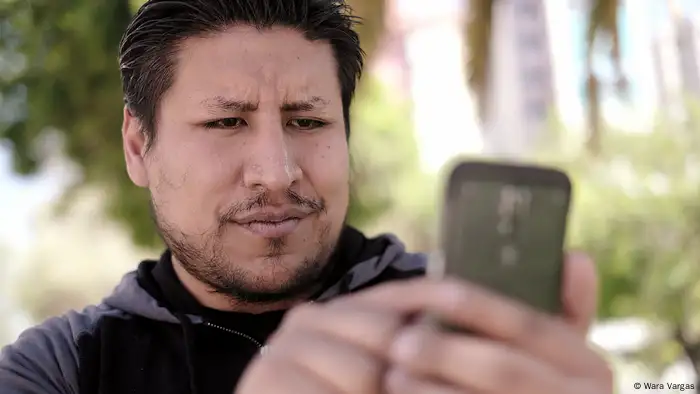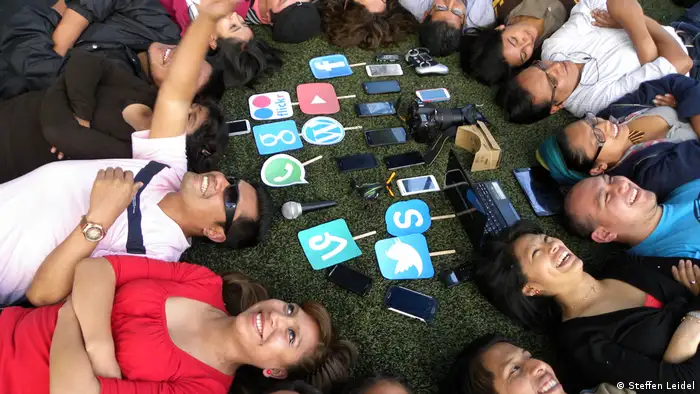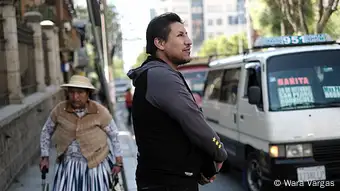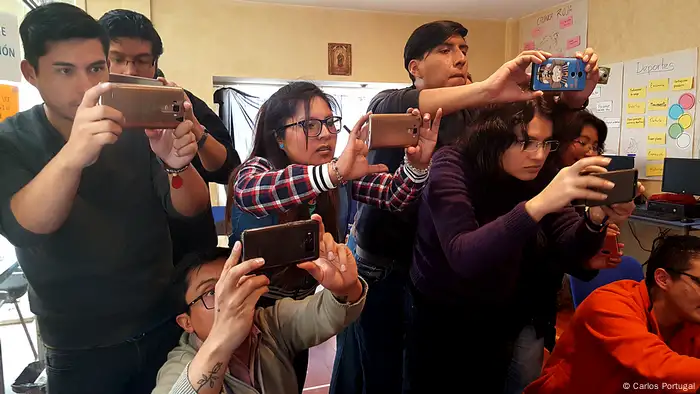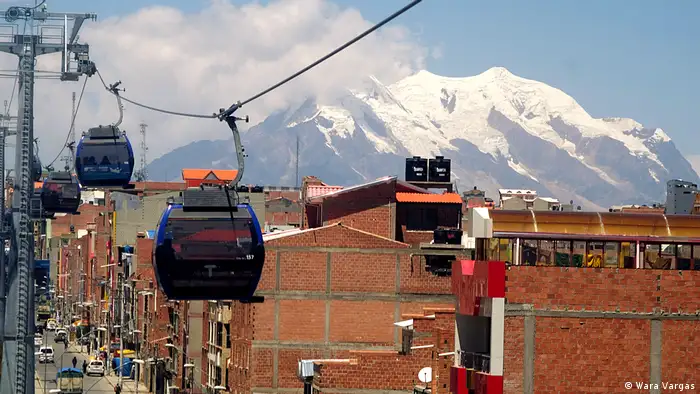our impact
Two tracks are better than one: A new course for journalism training
In Bolivia the introduction of a dual journalism training program, which combines theory and practical know-how, has spawned a new generation of self-confident multimedia experts now working across the country.
Yellow gondolas rattle above the rooftops of La Paz. Cable cars are a common means of transport for the inhabitants of the Bolivian metropolis. Tourists get on board so they can take in a bird's-eye view of the city. Bolivia's administrative capital inhabits a deep valley high in the Andes, 3,600 meters above sea level. It is a conglomeration of modern homes, colonial buildings, and simple wooden huts perhed up and down the steep valley walls. At night, the city is transformed into a sea of lights.
One of those lights is the Fundación para el Periodismo (FPP - Foundation for Journalism) which is based in a big yellow building in the popular arts district of Sopocachi. The foundation's 15-member team always keeps the front door open, welcoming a potpourri of journalists from all over the country who want to exchange ideas on how to become a better reporter.
It's been five years since César Sánchez first walked through that front door. At that time he was finishing his studies in communication science. One of his lecturers told him about a new training opportunity for journalists focusing on multimedia news production utilizing both theory and practice.
"When I read the description, I thought that I could not possibly apply, that they were looking for much more experienced applicants than myself," recalled the 28-year-old journalist from La Paz.
The syllabus for the one-year dual education program covered a lot of topics the young graduate student had little contact with, including digital and data journalism, video, and more. In addition, the program offered the opportunity to get practical work experience at renowned Bolivian media houses. Sánchez initially hesitated. Apart from a few internships, he had gained hardly any practical experience during his studies.
"But I had nothing to lose and such specialization for journalists was something completely new in Bolivia," he said.
So Sánchez sent in his application and was accepted. He became a member of the first generation of "edualeños," as the participants of this "dual journalism education" have since been dubbed. Edualeños translates loosely into something like “the duals.”
Journalism training that clicks
Since the project’s launch five years ago, the Fundación para el Periodismo has been a steadfast partner of DW Akademie. Three rounds of trainees, around 45 junior journalists, have already deliberated, discussed, researched, and brooded over journalistic topics in the foundation's seminar room.
"Right in the first lesson, it just clicked for me," recalled Sánchez.
In a seminar on multimedia journalism, a lecturer from Germany showed him a number of digital tools and programs. As a journalist, he had mostly just focused on writing texts. Now he was learning what the Internet can offer him and his journalistic work.
"I learned to shoot videos with my mobile phone, edit them and upload them to a website," he said. He also learned how to use Facebook and Twitter and how he can target social media users to attract more hits for his articles.
This dual journalism training was not only the first of its kind in Bolivia, it remains the only one offering a journalism-specific curriculum. Of the 44 communication programs offered nationwide, only four offer journalism-related courses. A dedicated degree in journalism does not exist.
In their year of training at the Fundación para el Periodismo, journalists go through a total of ten seminars on topics such as investigative journalism, reporting using mobile phones–so-called "mobile reporting"–and economic reporting. Multimedia storytelling is always in the foreground. Trainees are taught to deliberate which medium to use when telling a story, how to post videos or audios to a website and which stories can be shared via social media. Each month, after the week-long seminar is complete, the trainees return to their respective media houses for the rest of the month to implement their new skills in a real-world environment. There they are supervised by an experienced editor who acts as a mentor.
Sánchez took full advantage of the opportunities the program offered him and began to post stories online. He wrote about economics, adding specially created infographics to his articles. When he wrote about sports, he edited short videos and linked them to his texts. If he wanted to know more about a particular application, he just googled it and watched tutorials.
"I've learned that as a journalist you should always try new things," said César.
"Edualeños" know how journalism work.
Every participant in the dual journalism training program has a permanent position in a Bolivian media house, including national daily newspapers and radio and TV stations from all over the country. The media industry also benefits from the "edualeños."
"Journalism has become more diverse and new genres are constantly being added," said Thania Sandoval, director of ATB television in La Paz. Her station and two other media houses, including one of the country's most influential newspapers, have supported the program since its outset. Sandoval recalled the frustration faced by many young journalists who had to dive right into the job without any practical experience.
"Young people would often come to us and did not even know how to attribute correctly, let alone conduct an interview," said Sandoval. Her team was forced to first introduce basic journalistic how-to while at the same time dealing with the stress of day-to-day editorial work.
"I know that the edualeños have been taught by various experts on how journalism works and how to be at home in the digital world. They bring with them everything a journalist needs," said Sandoval.
After finishing his training, Sánchez worked for two years as a reporter for the Bolivian magazine Oxígeno where he completed the practical requirement for the program. During his time there, he developed a predilection for time-consuming research and complex topics. After reporting the story of a young woman who became a victim of human trafficking, his career as an investigative reporter was launched. Two years later, he switched to the online department.
"That's where I found my place," he said.
Only three people work for the portal, Sánchez, another aurthor, and their boss. It’s a small team in which the young journalist has established himself as a digital all-rounder. He tweets, does sports coverage, edits videos and covers political events.
"I always work, even on weekends," he said with a laugh. The market for digital journalism has grown significantly in Bolivia over the past three years.
"Previously, articles from the newspapers were simply copied and pasted," said Sánchez. "In the meantime, every medium to large newspaper has an online presence and many even have their own data journalism department." The editors are desperately looking for reporters who have learned how to prepare stories for the web. Sánchez, for one, does not need to think twice about the benefits of dual journalism training.
"It's not like at university or at school where you are punished and have to repeat yourself if you've done something wrong," he explained. "I've learned to keep coming up with new challenges."
For example, when Sánchez managed to land an interview with a well-known Mexican singer. "At the beginning of my journalistic career, I would not even have dared to dream of that," he said. "I have learned to have confidence in myself." Today, Sánchez can only smile about being afraid to submit his application for the program.
"César has an impressive career," said Renán Estenssoro, director of the Fundación para el Periodismo. "He is one of the best in the digital world." Estenssoro closely follows the careers of his graduates.
Sánchez was already on the jury for "Online Journalism" for the "Premio Nacional de Periodismo," the country's most important journalism award. It was a highlight in the career of the young journalist. He laughed when he was asked if he has already received offers from other media companies, “Oh yes, some!” he answered. But a change is not an option for him at the moment. “For now, I just want to ensure that online journalism in Bolivia is taken even more seriously.”
Sánchez still maintains close contact with his former colleagues. Many now work as journalists for private as well as state-run media companies in the country. They have organized a WhatsApp group where they discuss a wide variety of topics and share their scoops about the political happenings in the city.
"We have become a family," he explained. Not infrequently, junior journalists have called him ask for specific tips on how to use this or that program for their website or blog.
For the past year year, Sánchez has also been working as a trainer for the dual journalism program. "This decision was actually an obvious one for me as I come from a family of teachers myself," he said with a wink. Through social media, Sánchez watches intently as his protégés develop as journalists.
"Whenever I watch successful live event on Facebook or see an interactive graphic, I know immediately that this coverage could only have come from an ‘edualeño,’" he explained proudly.
The author: Vera Freitag is a big fan of dual journalism training. She went through it herself as a trainee (Volontariat) at Deutsche Welle. She recognizes that journalism training must be open to creativity and have the freedom to test out new technologies. As the DW Akademie project manager for Bolivia, Vera Freitag understands that part of her role is to constantly rethink journalism training so advances in technology and society can be addressed.
Profile: Bolivia
Who?
- The journalism foundation "Fundación para el Periodismo" (FPP) in La Paz promotes dual training for aspiring journalists.
What does the project want to achieve?
- Journalists are given the opportunity to receive practical training and to establish themselves as specialists in multimedia journalism.
How does the project work?
- Since 2014, young journalists from all media and all parts of the country have spent a year attending seminars on a wide range of journalistic topics. They then have the opportunity to apply these skills in a practical phase in participating media houses.
- "Little theory, a lot of practice" is the recipe for success of dual training. Participants have to step up to the mic, stand behind and in front of the camera, and hit the street for interviews.
- Through the combination of theory and practice, they are specifically trained as multimedia experts.
What are the difficulties?
- Bolivian media outlets do not have sufficient resources to invest in the training of media professionals.
- Of the 44 communication courses offered nationwide, only four touch on the topic of journalism. There is no regular journalism course of study so graduates lack basic journalistic knowledge when they start their careers.
What has the media project achieved?
- Graduates of the dual training program have risen to leading positions in their media companies and have introduced new, innovative editorial content a thanks to their extensive knowledge of digital media.
- 80 percent of participants are either taken on by media companies, continue their work, or rise to higher editorial positions.
What are the highlights?
- Former graduates of the program now educate future generations. In the beginning, the program relied on trainers from Germany. This was followed by international and Bolivian experts. Soon, the training will be taken over completely by Bolivian trainers.
- The dual journalism training in Bolivia is not only the first, but is still the only one of its kind.
WWW links
- Date 18.03.2020
- Author Vera Freitag
- Feedback: Send us your feedback.
- Print Print this page
- Permalink https://p.dw.com/p/3ZcJj
- Date 18.03.2020
- Author Vera Freitag
- Send us your feedback.
- Print Print this page
- Permalink https://p.dw.com/p/3ZcJj

